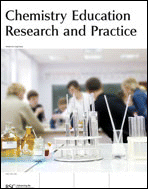Origami: a versatile modeling system for visualising chemical structure and exploring molecular function
Abstract
The use of Origami is presented as an accessible and transferable modeling system through which to convey the intricacies of molecular shape and highlight structure-function relationships. The implementation of origami has been found to be a versatile alternative to conventional ball-and-stick models, possessing the key advantages of being both inexpensive and readily accessible. The challenge, tangible nature, sense of achievement and hence trophy-like status of the models were found to combine and serve as a potentially invaluable outreach resource in terms of transfer to the home environment, with most (>70%) participants) wishing to show them to friends and family. A range of models were constructed and their implementation as lecture aids in both secondary and tertiary curricula has been assessed.

 Please wait while we load your content...
Please wait while we load your content...